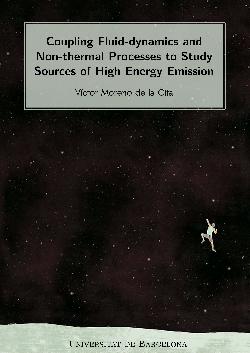ICCUB THESIS – Coupling Fluid-dynamics and Non-thermal Processes to Study Sources of High-Energy Emission [NOT TRANSLATED]

- By Víctor Moreno de la Cita (Dept. Física Quàntica i Astrofísica)
- Director: Valentí Bosch Ramon, Dmitry Khangulyan
In this thesis we have developed a tool for the computation of non-thermal emission in astrophysical sources. The code reads the hydrodynamic data coming from relativistic hydrodynamic simulations and compute the injection, evolution and radiation of non-thermal particles.
The emission channels explored in the thesis are mainly Inverse Compton (IC) and synchrotron. Making use of this tools, we have studied the following sources: Star-jet interactions in AGN
Some galaxies with an Active Galactic Nucleus (AGN) present two jets of relativistic particles. The pressence of this jets is linked with the merge of galaxies, as well as the posibility of starbursts. Therefore, it is plausible that an important amount of stars could interact with the relativistic jets.We have expored that situation performing simulations of an encounter between the jet and an isolated star. The result or our simulations is a potentially observable gamma-ray emission related with this interactions.
Pulsar wind interacting with a clumply stellar wind Gamma-ray binaries are two-body systems in which one of the objects is compact (either a neutron star or a black hole) and the other one is a star, with their spectral energy distribution (SED) peaking above 1 MeV (gamma rays). Here we focus on the cases in which the companion star is massive, presenting strongly inhomogeneous winds with clumps. The interaction of one of these clumps with a pulsar wind is simulated, and the results obtained showed that this type of inhomogeneities enhance the gamma radiation. An specific study of the source PSR B1259 − 63 was performed.
Clumpy wind-jet interactions in hmmqs High-mass microquasars (HMMQs) are binaries compound by a high-mass star and a compact object accerting material. The compact object form two collimated jets and here we explore the possibility that the jet interacts with a stellar wind inhomogeneity, or clump. We found that for the clump with the studied characteristics, the inhomogeneity is able so survive enough time to emit gamma rays before disruption. Moreover, the luminosity levels found could be enough to explain the observations of Cyg X- 1 and Cyg X-3 adopting conservative parameters. A specific study for Cyg X-1 was carried out. [NOT TRANSLATED]
